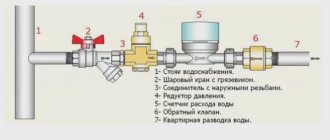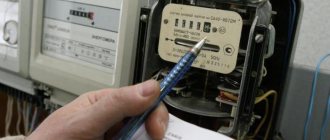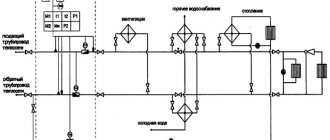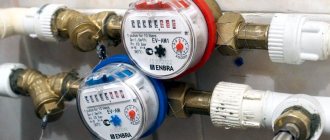In order for a person to know how to correctly calculate the amount that needs to be paid for utility bills, he needs to at least familiarize himself with, or better yet study in detail, the regulatory legal acts that govern this issue. If a person knows how to correctly recalculate the actual cost of housing, then he will be able to avoid unpleasant nuances associated with overpayment or underpayment of bills. And the whole set of these processes is called a housing and communal services calculator.
How to count water using a meter: example
Many users are concerned about the question of how to calculate water using a meter. The first five digits, which are black, are transmitted to the controlling company. These are cubes of water consumption for a certain time. If a new device was installed, and at the end of the reporting period the value on it, for example, is 00024843, then this means that consumers in this house used 24 cubic meters and 843 liters of water. So how to correctly calculate how much to pay? When transmitting readings to the monitoring company, it is advisable to round them up, that is, transfer 24 cubic meters. If after another month the meter readings correspond to 000495900, in order to calculate how much to pay, the readings of the previous month should be subtracted from them. Here's how to calculate it:
49 — 24= 25
The calculation system is not at all complicated. That is, the consumption of the last month is 25 cubic meters, therefore, we will find out how much to pay after multiplying by the tariff for 1 cubic meter. In subsequent billing months, payment is also calculated.
How to fill out a receipt
At the moment, almost all accruals for consumed resources are carried out automatically. This provides a more convenient calculation procedure and eliminates errors, but does not relieve owners of houses and apartments from the need to check information.
https://www.youtube.com/watch?v=pAXKT-ocKg0
In some situations, you may need to fill out the receipt yourself.
Sample of filling out a receipt
Step-by-step instruction:
- The period of document generation is indicated. All values must be entered legibly, without errors or corrections.
- Personal information is entered into the corresponding line of the table: full name, address, household IPU number, if it has not been registered previously.
- The number of people registered in the apartment or house and the number of persons entitled to receive benefits are indicated.
- If any, the debt or overpayment is included. The name of the service is marked taking into account the unit in which it is measured and the time period.
- The volume of consumption for the billing period is entered.
- Enter the full amount to be paid, after which you need to calculate the total taking into account benefits.
- All information is clarified and confirmed by signature.
- If during the specified period the meter was being calibrated, then consumption will be measured based on the average value for 3 or 6 months.
The completed receipt must be submitted to the institution that provides admission.
How many Gcal in 1 m3 of hot water
How to calculate hot water? You have to pay more for hot water supply, because it uses heat to heat it up. So how many Gcal are in 1 m3 of hot water? In today's difficult living conditions, the topic of saving is extremely acute.
Important! 1 Gcal is the amount of heat required to warm a thousand cubic meters by one degree. It follows from this that there are 0.001 Gcal in one cubic meter. When calculating, this value is added to the total losses in the house, which are caused by the inevitable cooling of the water while it reaches the payer’s apartment. The pipes through which this resource passes are a common property, so everyone must also pay for these losses.
The price of hot water especially increases where it passes through heated towel rails in bathrooms, in fact heating the entire room. In this case, up to thirty-five percent of heat can be lost. Rather, these heat costs relate to heating. But the meter doesn’t know this; it only calculates the flow rate that has reached it.
Unfortunately, it is impossible to change the existing pipe layout. It is not recommended to throw away heated towel rails, because they are a component of the heating system; without them, the normal circulation of the resource through the pipes will be disrupted. In this case, it will need to be drained for a long time, which will definitely cost a pretty penny.
There is another concept of 1 cubic meter of hot water - for heating. The amount of heat for DHW does not change in this case either. But the usual method of calculation in this case is incorrect. What do these columns mean on the receipt and what does the payment consist of?
The consumer divides the indicators from column Q by column V1, i.e. Gcal per m3, resulting in a huge value. This is especially true for those who have volatile automation installed. In this case, the figures are significantly overestimated. The user is perplexed why they have to pay so much more for a cubic meter of water. Why was it necessary to bear the costs of installation and a new device if the price for the consumed water supply has not decreased? Is the company lying?
Important! One Gcal is the volume of heat that is needed to heat a thousand cubic meters of water by one degree (it would be more correct to say thousands of tons). The note about tons was not made in vain, because the density of water at different pressures and temperatures is not the same. When heated, it expands and its quantity increases. But when she went around all the apartments, her temperature drops and the volume decreases, but in tons it remains unchanged.
The error may be caused by the inaccuracy of the measuring instruments themselves. A discrepancy may occur when heat consumption is less than 0.5 Gcal hourly, since reprogramming is possible based on the actual pressure in the IHP. Pressure does not have a significant impact on overall accounting (no more than 0.1 percent of overall accuracy). An error may also be made when calculating the temperature difference between the hot water supply and return data.
Calculation of charges for cold water supply in an apartment building
Comments
In accordance with the Rules for calculating the amount of payment for utility services, approved by Decree of the Government of the Russian Federation dated May 6, 2011 No. 354 “On the provision of utility services to owners and users of premises in apartment buildings and residential buildings” (hereinafter referred to as the Rules), consumers pay for cold water supply provided in residential or non-residential premises .
Calculation of charges for cold water supply
In addition, if the owners of an apartment building choose direct management, or the management method is not selected, or the selected management method is not implemented , then consumers pay separately for utilities consumed in the residential or non-residential premises of the apartment building, as well as fees for utilities provided for the maintenance of the common property of such a house - utilities provided for general house needs .
If the owners of the premises choose a management method - a management organization, HOA, housing cooperative or other specialized cooperative , payments for utilities consumed for the maintenance of the common property of an apartment building are included in the housing maintenance fee .
When choosing a methodology for charging for cold water supply in accordance with the Rules, it is necessary to take into account the following: methods of equipping residential premises (apartments) and non-residential premises in an apartment building with individual metering devices for cold water supply, as well as the presence or absence of a common house (collective) metering device at the house.
Below we will discuss the methodology and give examples of calculating the amount of payment for cold water supply in a residential building (apartment) located in an apartment building, as well as payment for cold water supply consumed for the purpose of maintaining common property in an apartment building (ADN), according to the methodology of the Rules.
Calculation No. 1 - Amount of payment for cold water supply provided in a residential premises (apartment) equipped with an individual cold water supply meter (Formula No. 1)
Calculation No. 2 - the amount of payment for cold water supply provided in a residential premises (apartment) that is not equipped with an individual cold water supply meter, in the absence of the technical ability to install such a meter (Formula No. 4)
Calculation No. 3 - the amount of payment for cold water supply provided in a residential premises (apartment) that is not equipped with an individual cold water supply meter, if it is technically possible to install such a meter (Formula No. 4(1))
Calculation No. 4 - the amount of payment for cold water supply provided for the purpose of maintaining the common property (CP) of an apartment building that is not equipped with a common house (collective) cold water supply meter (Formula No. 10, 15)
Calculation No. 5 - the amount of payment for cold water supply provided for the purpose of maintaining the common property (CHP) of an apartment building equipped with a common house (collective) cold water supply meter (Formula No. 10, 11)
Calculation of the fee for cold water supply in an apartment located in an apartment building
Calculation No. 1 - the amount of the fee if there is an individual meter for cold water.
The amount of payment for cold water supply in residential/non-residential premises equipped with an individual and (or) general (apartment) cold water metering device is determined in accordance with paragraphs 42 and 43 of the Rules, according to formula No. 1 :
Formula No. 1
Pi = ViP x Tcr
ViП - volume (quantity) of cold water consumed during the billing period in a residential or non-residential premises, determined according to the readings of an individual or general (apartment) meter.
Tkr is the tariff (price) for cold water supply, established in accordance with the legislation of the Russian Federation.
EXAMPLE OF CALCULATING THE AMOUNT OF FEE FOR COLD WATER SUPPLY USING FORMULA No. 1
First of all, we determine that this calculation is performed:
» for an apartment located in an apartment building; » the apartment has an individual meter for cold water;
INITIAL DATA FOR CALCULATION:
The volume of cold water supply consumed according to the readings of your individual meter for January 2019 was 8 cubic meters (m3) (ViP - in the formula).
The tariff for cold water supply established for your region and service provider is 26.32 rubles. per 1 cubic meter (m3) (Tcr - in the formula).
The amount of payment for cold water supply for your apartment will be calculated as follows:
8 m3 x 26.32 rub. = 210.56 rubles
The total fee for cold water supply in your apartment will be 210.56 rubles.
Calculation No. 2 - the amount of payment for cold water supply in the absence of an individual meter for cold water; there is no technical possibility of installing such a device.
Calculation of the amount of payment for cold water supply in a residential premises (apartment) that is not equipped with an individual meter for cold water, and in the absence of the technical ability to install such a meter, is made according to formula No. 4 of Appendix No. 2 of the Rules.
Formula No. 4
Pi = nj x Nj x Tcr
nj is the number permanently and temporarily residing in the apartment.
Nj is the standard established for cold water for your region.
Tkr is the tariff set for cold water supply for your region and service provider.
EXAMPLE OF CALCULATION OF THE SIZE OF FEE FOR COLD WATER SUPPLY USING FORMULA No. 4
First of all, we determine that this calculation is performed:
» for an apartment located in an apartment building; » the apartment does not have an individual meter for cold water; there is no technical ability to install an individual meter;
INITIAL DATA FOR CALCULATION:
3 people living in your apartment (nj - in the formula).
The standard for cold water established for your region is 6.4 cubic meters (m3) per person (Nj - in the formula).
The cold water supply tariff established for your region and service provider is 26.32 rubles per 1 cubic meter (m3) (Tcr - in the formula).
The amount of payment for cold water supply for your apartment will be calculated as follows:
3 people x 6.4 m3 x 26.32 rub. = 505.34 rubles
The total fee for cold water supply in your apartment will be RUB 505.34.
Calculation No. 3 - the amount of payment for cold water supply in the absence of an individual meter for cold water, but it is technically possible to install such a meter.
Calculation of the amount of payment for cold water supply in a residential premises (apartment) that is not equipped with an individual meter for cold water, but it is technically possible to install such a meter, is made according to formula No. 4(1) of Appendix No. 2 of the Rules.
Formula No. 4(1)
Pi = nj x Nj x Kpov x Tcr
nj is the number permanently and temporarily residing in the apartment.
Nj is the standard established for cold water for your region.
Kpov - increasing coefficient equal to 1.5 from January 1, 2020.
Tkr is the tariff set for cold water supply for your region and service provider.
EXAMPLE OF CALCULATION OF THE SIZE OF FEE FOR COLD WATER SUPPLY USING FORMULA No. 4(1)
First of all, we determine that this calculation is performed:
» for an apartment located in an apartment building; » the apartment does not have an individual meter for cold water, but it is technically possible to install such a meter .
INITIAL DATA FOR CALCULATION:
3 people living in your apartment (nj - in the formula).
The standard for cold water established for your region is 6.40 cubic meters (m3) per person (Nj - in the formula).
The increasing coefficient is 1.5 (Kpov - in the formula).
The cold water supply tariff established for your region and service provider is 26.32 rubles per 1 cubic meter (m3) (Tcr - in the formula).
The amount of payment for cold water supply for your apartment will be calculated as follows:
3 people x 6.40 m3 x 1.5 x 26.32 rub. = 758.02 rubles
The total fee for cold water supply in your apartment will be 758.02 rubles.
The procedure for calculating the amount of payment for cold water supply provided for general house needs.
Calculation No. 4 - the amount of payment for cold water supply provided for common building needs in an apartment building that is not equipped with a common building meter for cold water supply.
Calculation of the amount of payment for cold water supply provided for general house needs in an apartment building that is not equipped with a common building meter is made using formulas No. 10 and No. 15 . Formula No. 15 calculates the volume of cold water, and formula No. 10 calculates the amount to be paid.
Formula No. 10
Piodn = Viodn x Тcr
Viodn - volume (quantity) of cold water provided during the billing period for general house needs in an apartment building and per residential premises (apartment) or non-residential premises.
Tkr is the tariff for the corresponding communal resource (cold water supply), established in accordance with the legislation of the Russian Federation.
Formula No. 15
Nodn - consumption standard for cold water supply provided for the billing period for general house needs in an apartment building, established in accordance with the Rules for establishing and determining utility service consumption standards, approved by Decree of the Government of the Russian Federation of May 23, 2006 No. 306
Si - total area of residential premises (apartment) or non-residential premises in an apartment building
Sob - the total area of all residential premises (apartments) and non-residential premises in an apartment building
Soi - the total area of premises that are part of the common property in an apartment building
EXAMPLE OF CALCULATION OF THE AMOUNT OF CHARGES FOR COLD WATER SUPPLY PROVIDED FOR GENERAL HOUSEHOLD NEEDS, ACCORDING TO FORMULA No. 15
First of all, we determine that this calculation is performed:
» payment for cold water provided for general house needs for an apartment located in an apartment building; » a common house meter for cold water supply is not installed in the apartment building ;
INITIAL DATA FOR CALCULATION:
The standard for cold water supply provided for general house needs , established for your region, is 0.54 cubic meters (m3) per 1 m2 (Nodn - in the formula).
The total area of the premises that are part of the common property of the owners of the premises of an apartment building is 400 m2 (Soi - in the formula).
The area of residential premises (apartments) of an apartment building is 6000 m2 (Sob - in the formula).
The total area of your apartment is 45 m2 (Si is in the formula).
The tariff for cold water supply established for your region and service provider is 26.32 rubles. per 1 cubic meter (m3) (Tcr - in the formula).
The amount of payment for cold water supply provided for general house needs will be calculated as follows:
1. First of all, it is necessary to determine the volume of cold water provided for general household needs using formula No. 15 :
The total volume of cold water provided for general household needs will be 1.62 cubic meters (m3)
2. Then, we calculate the size of the fee using formula No. 10 :
1.62 m3 x 26.32 rub. = 42.64 rub.
The total payment for cold water supply provided for general household needs will be 42.64 rubles.
Calculation No. 5 - the amount of payment for cold water supply provided for common building needs in an apartment building equipped with a common building meter for cold water supply.
The calculation of the amount of payment for cold water supply provided for general house needs , in this case, will be made according to formulas No. 10 and No. 11 . Formula No. 11 calculates the volume of cold water, and formula No. 10 calculates the amount to be paid.
Formula No. 10
Piodn = Viodn x Тcr
Viodn - volume (quantity) of cold water supply provided during the billing period for general house needs in an apartment building and per residential premises (apartment) or non-residential premises.
Tkr is the tariff for the corresponding communal resource (cold water supply), established in accordance with the legislation of the Russian Federation.
Formula No. 11
Where:
Vd - volume (quantity) of cold water consumed during the billing period in an apartment building, determined according to the readings of the collective (common house) cold water meter. In the cases provided for in paragraph 59(1) of the Rules, to calculate the amount of payment for utility services, the volume (quantity) of the utility resource determined in accordance with the provisions of this paragraph is used;
Vutezh. - volume (quantity) of cold water consumed during the billing period in the u-th non-residential premises, determined in accordance with paragraph 43 of the Rules;
Vvzh.n. - volume (quantity) of cold water consumed during the billing period in the v-th residential premises (apartment), not equipped with an individual or common (apartment) metering device;
Vwresidential - volume (quantity) of cold water consumed during the billing period in the w-th residential premises (apartment), equipped with an individual or common (apartment) cold water meter, determined from the readings of such a meter. In the cases provided for in paragraph 59 of the Rules, to calculate the amount of payment for utility services, the volume (quantity) of the utility resource determined in accordance with the provisions of this paragraph is used;
Vigv - volume (quantity) of hot water (in the case of independent production of the utility service provider for hot water supply (in the absence of a centralized hot water supply)), consumed during the billing period in the i-th residential premises (apartment) or non-residential premises in an apartment building, defined in in accordance with paragraphs 42 and 43 of the Rules;
Vcr - the volume of cold water determined in accordance with paragraph 54 of the Rules, used by the contractor in the production of communal heating services (in the absence of centralized heating), which in addition was also used by the contractor in order to provide consumers with communal services for cold water supply;
Si is the total area of the i-th residential premises (apartment) or non-residential premises in an apartment building;
Sob - the total area of all residential premises (apartments) and non-residential premises in an apartment building.
EXAMPLE OF CALCULATION OF THE AMOUNT OF CHARGES FOR COLD WATER SUPPLY PROVIDED FOR GENERAL HOUSEHOLD NEEDS, ACCORDING TO FORMULA No. 11
First of all, we determine that this calculation is performed:
» payment for cold water provided for general house needs for an apartment located in an apartment building; a common building meter for cold water supply is installed in an apartment building ; » the apartment building contains non-residential premises
INITIAL DATA FOR CALCULATION:
The volume of cold water consumed according to the readings of the common house meter was 3250 cubic meters (m3) (VD - in the formula).
The volume of cold water consumed in the non-residential premises of the apartment building was 236 cubic meters (m3) (Vunezh. - in the formula).
The volume of cold water supply consumed in all residential premises according to the readings of individual metering devices amounted to 1568 cubic meters (m3) (Vwresidential - in the formula).
The volume of cold water supply consumed in residential premises not equipped with individual metering devices amounted to 1028 cubic meters (m3) (Vvzh.n. - in the formula), the calculation of the volume of cold water supply provided in premises not equipped with IPU for cold water is based on from the number of residents in these premises and the established consumption standard.
The volume of hot water (in the case of independent production by the utility service provider for hot water supply (in the absence of a centralized hot water supply)) consumed during the billing period in the i-th residential premises (apartment) or non-residential premises in an apartment building is 0 cubic meters (m3) ( Vigv - in the formula)
The volume of cold water used by the contractor in the production of communal heating services (in the absence of centralized heating) is 0 cubic meters (m3) (Vcr - in the formula).
The area of residential premises (apartments) and non-residential premises in an apartment building is 6,000 m2 (Sob - in the formula).
The total area of your apartment is 45 m2 (Si is in the formula).
The tariff for cold water supply established for your region and service provider is 26.32 rubles. per 1 cubic meter (m3) (Tcr - in the formula).
The amount of payment for hot water supply provided for general house needs will be calculated as follows:
1. First of all, it is necessary to determine the volume of cold water provided for general household needs using formula No. 11 :
The total volume of cold water provided for general household needs will be 3.135 m3
2. Then, we calculate the size of the fee using formula No. 10 :
3.135 m3 x 26.32 rub. = 82.51 rub.
The total payment for cold water supply provided for general household needs will be 82.51 rubles.
If you have questions about calculating the amount of payment for cold water supply, you can ask them in the comments to this article or post them on our forum.
Previous post Cold water supply in a communal apartment
How to challenge water heating regulations
What to do if the consumer does not agree with the standard for heating water, and is it possible to challenge it? Of course you can. For example, if a water heater breaks down, the water supply organization must repair it urgently. All residents must pay for the repairs if it is an apartment building.
If you need to resolve the issue individually, you should call the organization responsible for the water supply and call an inspector who will draw up a malfunction report. If you cannot reach an understanding with the company by any means, you can go to court. But in such cases, litigation is rarely resolved in favor of the residents.
A water meter helps save money, but it is important to be able to correctly interpret its readings and calculate payments. Determining how much to pay for each of the meters (for hot and cold water supply) is not at all difficult. You need to independently take into account the cubic meters consumed each month and compare them with the data in the housing and communal services receipt. As with all utilities, payments for water are made monthly. The Internet will help you find out what the tariff is this year.
Internal cold and hot water supply systems
Dear customers! All offices and warehouses of our company have resumed their work.Office and warehouse on the street. Obrucheva operates Mon-Fri from 09:00 to 20:00, Sat-Sun from 09:00 to 19:00. Office and warehouse on Simferopol Boulevard - Mon-Fri from 09:00 to 20:00, Sat-Sun from 09:00 to 19:00. Office and warehouse in Balashikha - from 09:00 to 19:00 daily.
Technical information
| Table of contents | Forward >> |
SNiP 2.04.01-85*
Building regulations
Internal water supply and sewerage of buildings.
WATER PIPES
7. Calculation of the cold water supply network
7.1. Hydraulic calculations of cold water internal water supply networks must be made based on the maximum second water flow.
7.2. The networks of combined utility-fire-fighting and industrial-fire-fighting water supply systems must be checked to pass the calculated water consumption for fire extinguishing, with the highest consumption for household, drinking and production needs, while the water consumption for using showers, washing floors, and watering the territory is not taken into account.
It is also not necessary to take into account the shutdown (reservation) of sections of the water supply network, risers and equipment.
Note. For residential areas, during fire extinguishing and liquidation of an emergency on the external water supply network, it is allowed not to provide water supply to a closed hot water supply system.
7.3. When calculating networks of utility, drinking, industrial and fire-fighting water supply systems, the necessary water pressures at the devices specified in the mandatory Appendix 2 and fire hydrants located highest and furthest from the input should be ensured, taking into account the requirements of clause 7.5.
7.4. Hydraulic calculations of water supply networks fed by several inlets should be made taking into account the shutdown of one of them.
With two inputs, each of them should be designed for 100%, and with a larger number of inputs - for 50% water consumption.
7.5. The diameters of the pipes of internal water supply networks should be determined based on the maximum use of the guaranteed water pressure in the external water supply network.
The diameters of the ring jumper pipelines should be no less than the largest diameter of the water riser.
7.6. The speed of water movement in pipelines of internal water supply networks, including during fire fighting, should not exceed 3 m/s, in sprinkler and deluge systems - 10 m/s.
The diameters of the pipelines of the water risers in the sectional unit should be selected according to the calculated water flow in the riser, determined in accordance with clause 3.3, with a coefficient of 0.7.
7.7. Pressure loss in sections of pipelines of cold water supply systems N, m, should be determined by the formula
(12)
Values should be taken:
0.3 - in networks of domestic and drinking water supply systems of residential and public buildings;
0.2 - in networks of integrated utility and fire water supply systems of residential and public buildings, as well as in networks of industrial water supply systems;
0.15 - in networks of integrated industrial fire-fighting water supply systems;
0.1 - in fire-fighting water supply networks.
7.8. When combining risers into sectional units, the pressure loss in the unit should be determined using the formula
(13)
where is a coefficient that takes into account the nature of water withdrawal in the system and is accepted:
0.5 - for domestic water supply systems;
0.3 - for fire-fighting water supply systems;
m is the number of risers in the node.
| Table of contents | Forward >> |
Skipping a payment
The information on receipts becomes even more mysterious if payments are missed. According to the Rules for the provision of utility services (clause 118), if the consumer partially pays for the utilities and maintenance services provided by the contractor, the contractor divides the payment received from the consumer between all types of utilities specified in the payment document and the fee for maintenance and repairs residential premises in proportion to the size of each payment indicated in the payment document. In this case, the contractor calculates the consumer's debt for each type of utility service based on the partially unpaid amount.
Drinking regime. How to calculate your norm?
Let's get ready for summer together and find out how much water you need to drink per day.
Photo: April 17, 2020, 14:30
We drink and lose weight. To lose weight, you need to eat less. But this is far from the most obvious truth. In fact, people often limit themselves very much in food, but the weight still stays the same and does not go away. Water itself, of course, will not lead you to weight loss, but it can create favorable conditions in the body, improve metabolism and help remove excess waste and toxins.
Water is a unique product - it has 0 calories. And this despite the fact that it contains many minerals and trace elements that are important for health. For this, it is very important to maintain a drinking regime. Despite the fact that its calculation is an individual matter for each person, there is a simple formula: your weight in kg / 450 × 14.
The reverse side of the regime. However, you should not suddenly rush to drink liters of water in unlimited quantities. Imagine how stressful this can be for your body (especially considering that you previously drank no more than two glasses a day). Such drastic changes in your drinking regime can lead to increased swelling. From this we conclude that it is important to know moderation in everything. The norm for the average person is 1.5-2 liters of clean water per day.
Water and juice are “two big differences.” Let's try to understand the situation: all you do is drink liquid, but this does not affect your weight in any way, you do not feel a surge of strength and an improvement in your condition. There may be a lot of reasons, but the most common mistake is: not every liquid is equally beneficial to our body. Therefore, if you are watching your health and nutrition, then try to quench your thirst with clean water without gas at room temperature.
Editor's tip: try sticking to this regimen for 10-15 days and notice changes in how you feel.
Water consumption should be comparable to its losses. During intense physical activity, you need to drink as much as you want. In order to promptly replenish the water-salt balance in the body, it is important to monitor certain parameters: water should be at room temperature, without gas or additives. The more natural and simpler in composition the liquid you consume, the faster it is absorbed by our body.
Note to readers:
In order for coffee to quickly give you vigor and strength, do not forget to drink a glass of water after a cup of espresso.
Nutritionists advise NOT to drink water during meals. It is optimal to drink one glass of water half an hour before and half an hour after a meal. This technique will help speed up your metabolism.
If you want your stomach and kidneys to work like a well-coordinated mechanism, make it a habit to drink a glass of water half an hour before bed and half an hour before breakfast.
Source "Championship"
Photo my.goodhouse.com.ua
More news in the Telegram channel “zakon.kz”. Subscribe!
report a bug
Report a bug 4854251-ab46c24d0d13d012d5b742a6ee2be314









